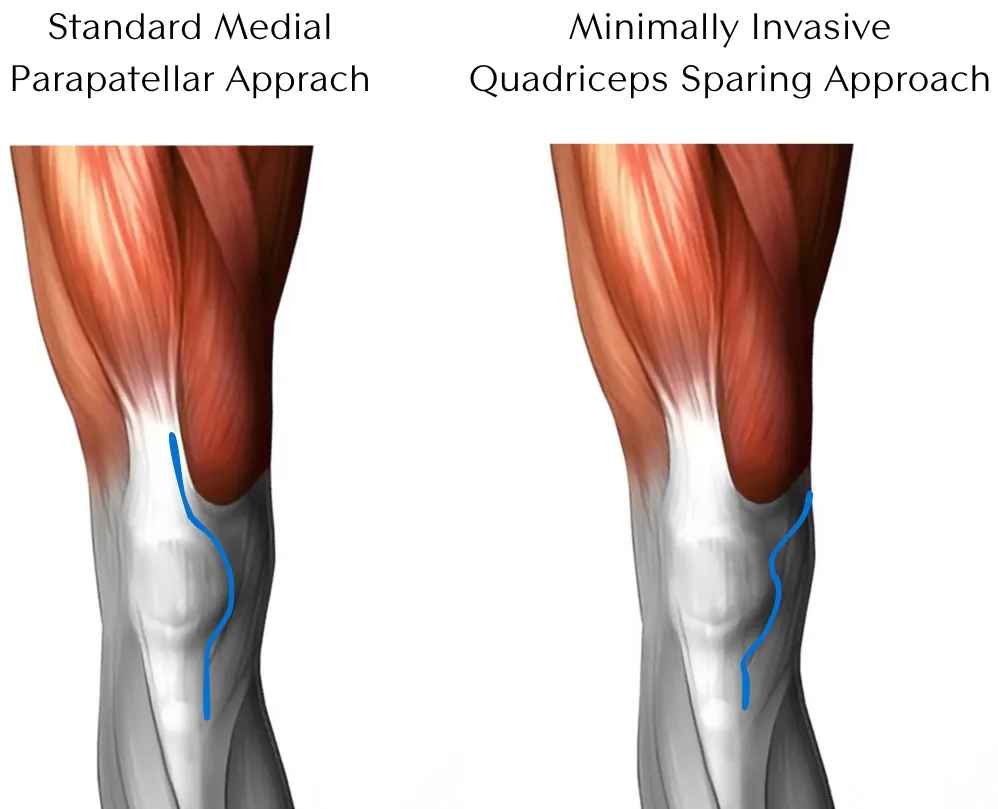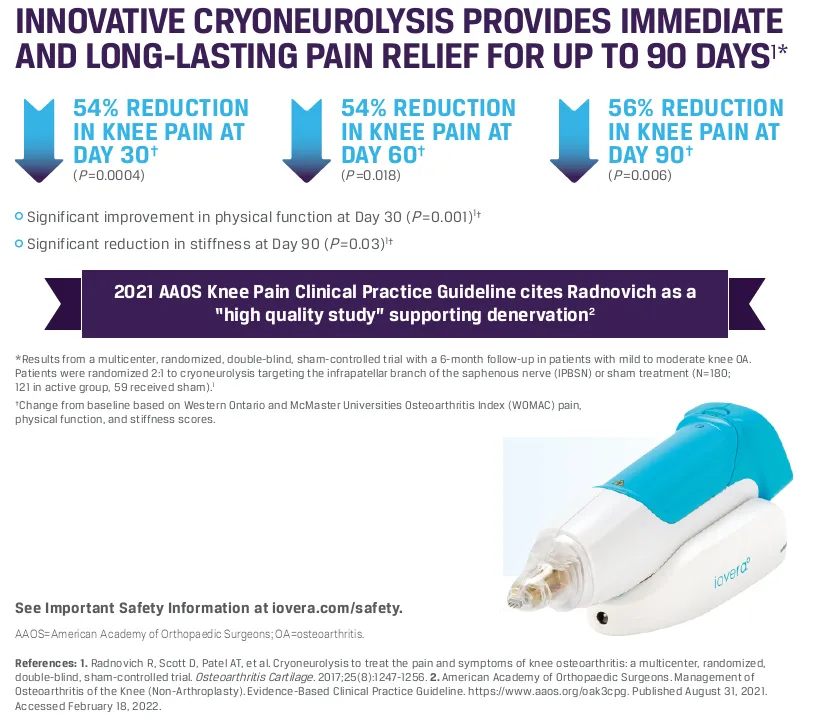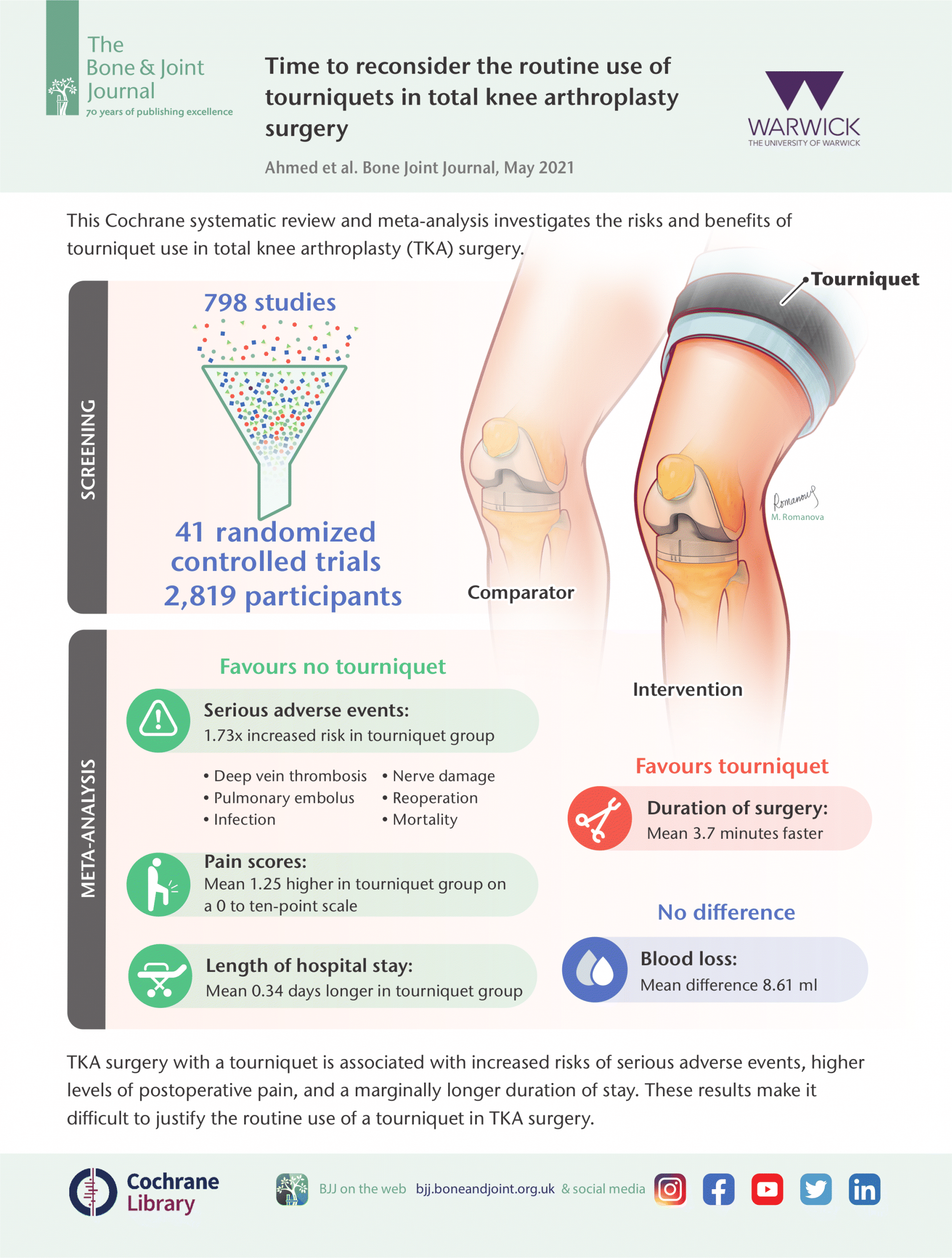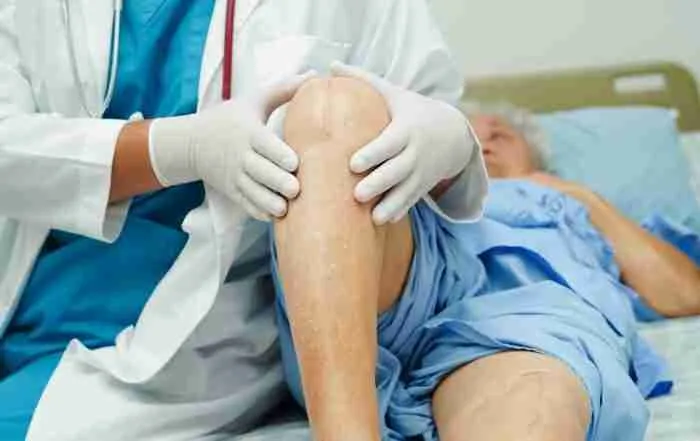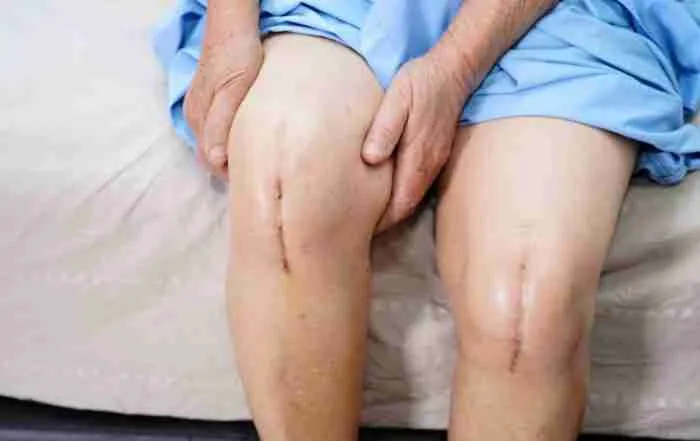Talk with Your Knee Expert Today!
Choose Dr. Morton as your Knee Replacement Surgeon
- Experienced Orthopedic Surgeon
- Most Surgeries Are Same-Day, Outpatient surgeries
- High success rate in treating knee pain and arthritis
- Minimally invasive incision, smaller incisions
- Performs both Minimally Invasive Total Knee Replacement and Partial Knee Replacements
- Less soft-tissue dissection
- Robotic technology
- More accurate implant positioning
- Less Postoperative Pain
- Latest Techniques
- Fellowship-trained and specialist in knee replacements
- Takes care of revision knee replacements and complex joint replacements
What should I expect with my total knee?
There is no reason to sacrifice your lifestyle when it comes to your knee pain. We use our knees every day when we sit, stand, or play with our children. Sometimes, our knees wear out due to injury, illness, or the normal aging process. When your knees become worn, your everyday movements can be painful and difficult.
With robotic knee replacement, I believe we are able to have our patients have their implants placed more accurately, with less soft-tissue injury and faster recovery.
You do not have to live with your aching knees. A knee replacement can help you maintain your quality of life. If your life is limited because of knee pain, you may be a candidate for knee replacement surgery.

Am I a Candidate for Robotic Assisted Knee Replacement Surgery?
When you have failed non-operative treatment for arthritis, you should consider a knee replacement. Non-operative treatment includes injections, anti-inflammatory medications, or exercise.
The goal of a knee replacement surgery is to alleviate your pain and improve function. The best time to think about surgery is when you are having difficulty with the following scenarios:
- Your daily living activities: household chores and grocery shopping
- Leisure activities: golf, gardening, long walks, bike riding
- Loss of ability to work due to pain
- Avoidance of seeing friends or family
Any patient who is a candidate for a total knee replacement is a candidate for a robotic knee replacement.

Diagnosis
Knee Replacement
When you have failed non-operative treatment for arthritis, you should consider a knee replacement. Non-operative treatment includes injections, anti-inflammatory medications, or exercise.
The goal of a knee replacement surgery is to alleviate your pain and improve function. The best time to think about surgery is when you are having difficulty with the following scenarios:
- Your daily living activities: household chores and grocery shopping
- Leisure activities: golf, gardening, long walks, bike riding
- Loss of ability to work due to pain
- Avoidance of seeing friends or family. A total knee replacement is a surgery that removes the damaged parts of your knee, which is replaced with an artificial joint. Your new knee is composed of metal and plastic. During the surgery, the metal is solidly fixed to the end of your thigh bone and your shin bone. Your knee replacement is made of a highly-engineered plastic, called polyethylene, that is inserted between the two pieces of metal. The kneecap is also replaced with a small plastic button. I may also consider you a candidate for a partial knee replacement, and will discuss this during your visit.

Minimally Invasive Knee Surgery
Minimally invasive surgery performed by Dr. Morton typically involves smaller incisions compared to traditional knee replacements. Below is a picture of a patient who recently underwent a right minimally invasive robotic total knee replacement at 5 months after surgery compared to a scar from surgery performed several years ago by a different provider in Hawaii. Over time, the surgery scars gradually fade in color. The surgical incision is roughly half the length compared to the competitor’s incision. With smaller incisions, there is a less pain and a faster recovery.
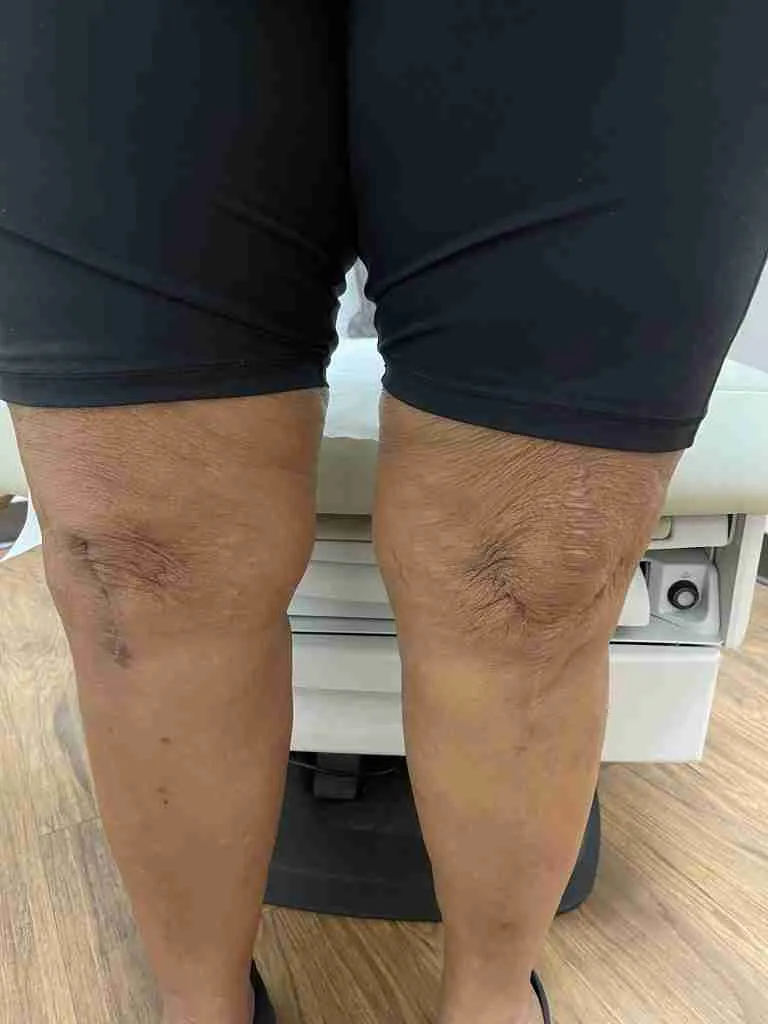
Minimally Invasive Knee Replacements incisions such as that seen on the right usually are 4- 6 inches long
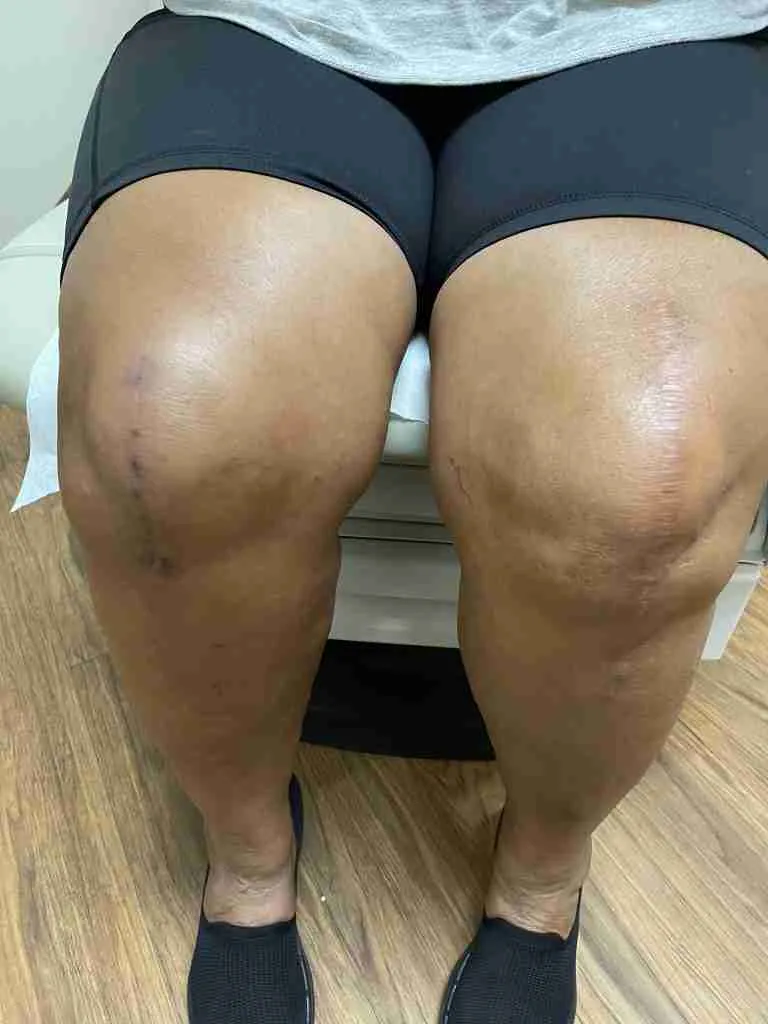
Traditional Knee Replacements incisions such as that seen on the left usually are 10-12 inches long.
Role of Robotic-Assistance in Hip and Knee Joint Replacement Surgery
Benefits of Robotic Surgery
The problem with conventional joint replacements
Hip and Knee replacement surgeries are incredibly successful operations. In fact, the Lancet named total hip replacements “the operation of the century.”
However, hip replacements are known to have problems with dislocations and limb length discrepancies. In patients with hip dysplasia or other deformities in their hips often have distorted anatomy. While anterior hip replacements have improved some of these problems, there is still room for improvement.
Knee replacements are considered an incredibly successful surgery. However, 20% of patients are still dissatisfied with their surgery. In studies of total knees performed on patients in Hawaii by excellent orthopedic surgeons using mechanical jigs, only 86% of these implants are placed in the appropriate position.
Keep reading to learn how robotics improves our surgical techniques.
Preoperative Planning
Prior to surgery, some robotic systems require the use of advanced imaging such as a long-leg standing film or a CT scan. This imaging allows for:
- Accurate sizing of implants prior to surgery
- Less guess-work on sizes before
- Shorter operating period
- Preoperative measurement of patient’s deformity prior to surgery
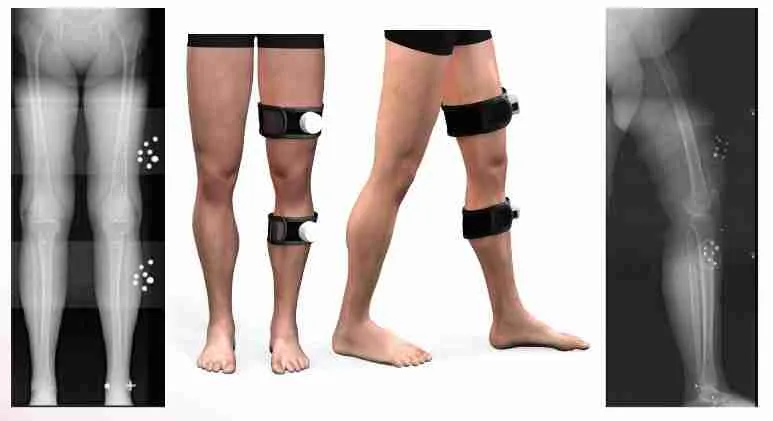
Rosa Knee Replacement uses x-rays with special calibration markers that allow for accurate determination of preoperative alignment and sizing. After these x-rays are obtained, a preoperative plan is personalized to each patient before surgery is even performed.
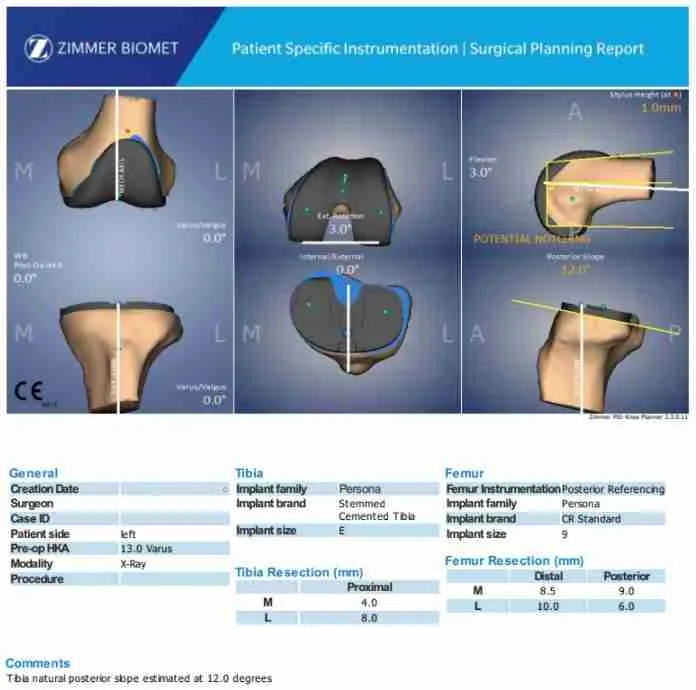
Performing a Robotic Surgery
Insertion of Pins and Calibration of the Robot
Navigation pins allow for the proper utilization of the robot.
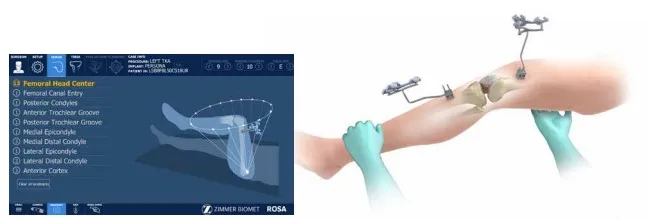
Exposure of the Joint
This is performed much in the same way that is done during a normal knee or hip replacement. Soft-tissue releases that are normally performed – do not have to be done.
Collection of Bone Landmarks
Dr. Morton will trace out the bone landmarks on your knee replacement, obtaining real-time information to map out your knee anatomy.
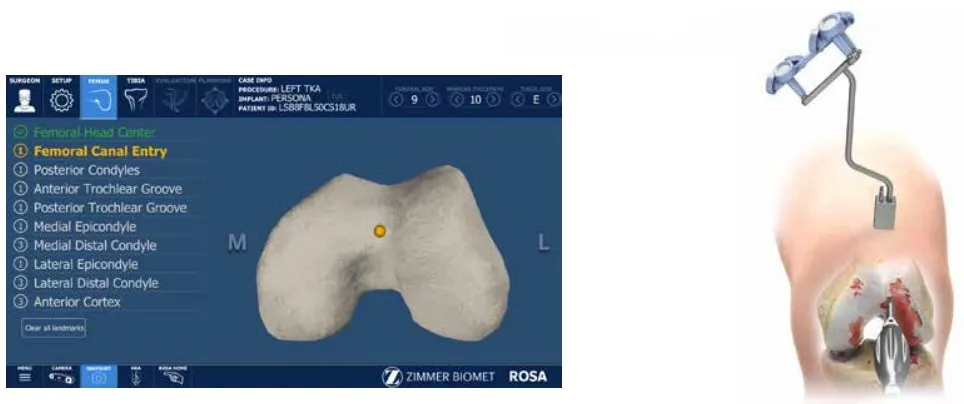
Soft-tissue balancing information
The soft-tissue gap balancing information obtained during a robotic joint provides information not normally evaluated during a knee replacement. This evaluation alerts the surgeon to your specific soft tissue anatomy and helps guide customized, patient-specific implantation of your hip or knee.
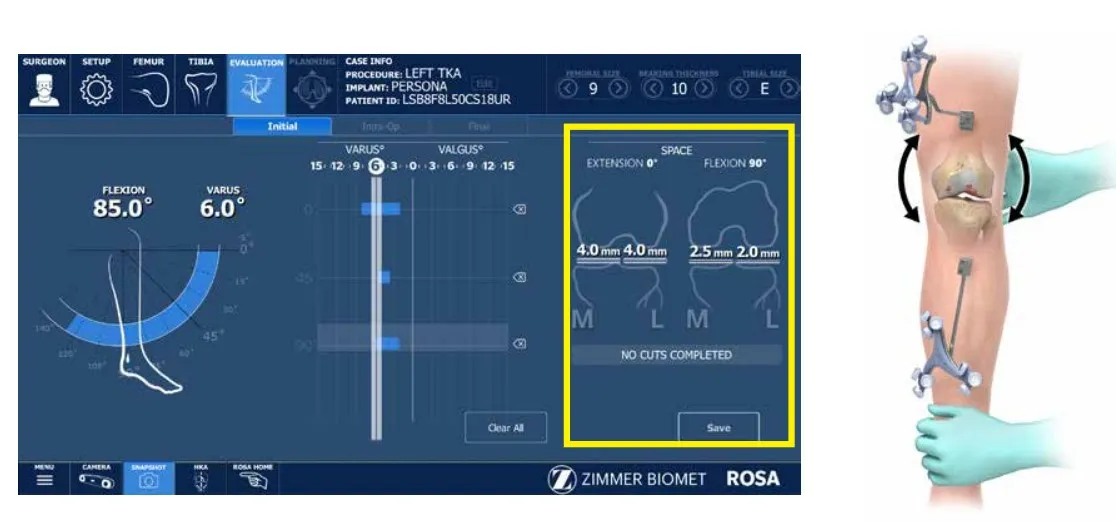
Implant positioning
Your surgery is then planned on a computer screen prior to the actual implantation.
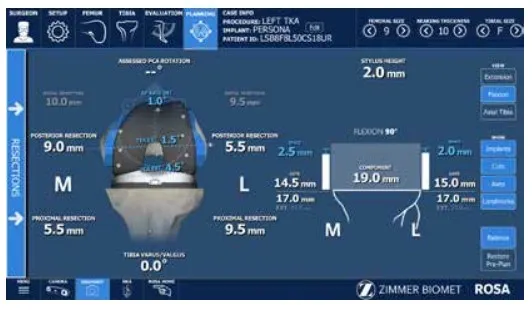
Robotic-assisted Bone Preparation
The robot then guides the cuts through the cutting guides. The robot provides an increased accuracy that cannot be matched by the human eye. These cuts are confirmed to be accurate after they are made.
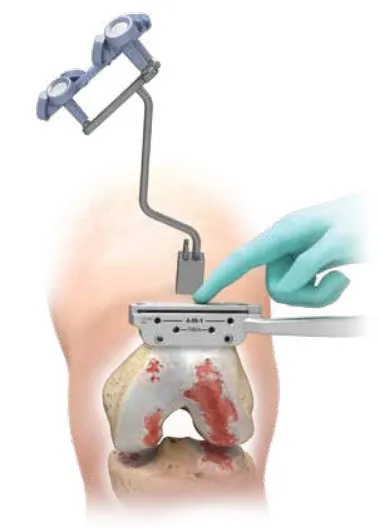

Placing the Implant
Once the bone cuts are made, Dr. Morton will place your new hip or knee in the correct position.
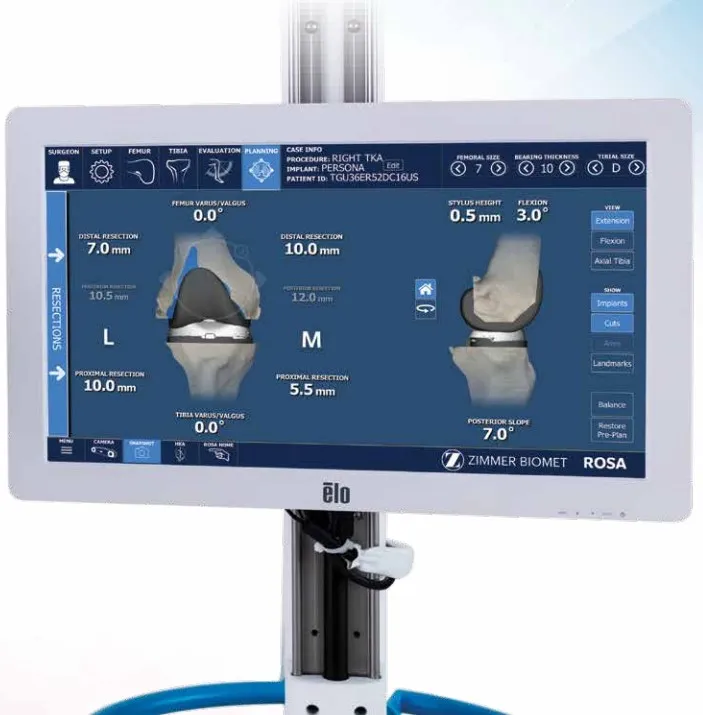
What’s the Recovery Like for a Total Knee or a Knee Replacement?
As the operation is over, you will use your new knee. Most patients begin to walk on the day of surgery with the help of a physical therapist. Your physical therapist will show you how to walk again with a walker as you are recovering. As your muscles heal, you will have some pain. During the first couple of weeks your pain and motion will improve. Over time, you will regain your strength. Pain after a knee replacement usually resolve over the next few weeks to months. We will provide you with pain medication after surgery and monitor you, making sure that you are comfortable.

What are my goals after Surgery?
Six weeks after surgery, most patients with sedentary jobs may return to work. Often, patients are able to walk comfortably by 3 months. Full recovery usually occurs at one year, but may take up to 2 years to have all of your aches and pains improve after knee replacement. Many patients with robotic surgery are recovering quicker than this timeline, but it is a useful guide to your recovery.
Knee replacements are designed to allow you to enjoy many activities such as long walks, dance, playing golf, gardening, and riding a bicycle. Knee replacements have an excellent track record for improving your quality of life, reducing your pain, and providing independence.
Realistic Expectations
When you are deciding to have a total knee replacement, you must understand the limitations to what the implant can do. Most people who have a total knee replacement have a dramatic reduction in their knee pain and a significant improvement in the ability to perform everyday activities. However, with normal activities, you will slowly wear the plastic piece in your knee replacement. The wear and tear can be sped up with excessive activity or weight. Damage to the plastic piece will cause the knee replacement to loosen or become painful. I agree with the American Academy of Orthopedic Surgeons and the American Association of Hip And Knee Surgeons in advising my patients to avoid running, jogging, jumping or other high-impact activities with a knee replacement.
Risks
Talk with Dr. Morton About Knee Replacement
Dr. Morton is one of the few orthopedic surgeons in Honolulu, Hawaii who is fellowship-trained in hip and knee reconstruction. He regularly takes care of complicated knee replacements, performs robotic knee replacements, total knee replacements, partial knee replacements, and revision knee hip replacements. He performs surgery at Queen’s Medical Center which has received Advanced Certification for total hip and total knee replacement from the Joint Commission and is the only hospital in the state of Hawaii that is rated as “High Performing” by US News. If you are suffering from hip pain, schedule an evaluation today!

Frequently Asked Questions About Knee Replacement (FAQ)
Long-distance travel should usually be avoided until at least after your initial post-operative visit with your surgeon. The concern with long-distance travel is the possibility of the development of a blood clot, or missing a postoperative complication.
Once you are on a long trip, Dr. Morton recommends that you get up to stretch or walk at least once per hour during a long trip. Taking 81mg of aspirin daily is a useful adjunct. Dr. Morton recommends starting aspirin 2 days before your trip, and 2 days after your trip to avoid blood clots. You may want to talk with your primary care physician if you have a history of stomach ulcers, allergies, blood clots, or bleeding disorders. Usually, patients will desire an aisle seat or a lay-flat seat for long distances during their initial recovery.
Robotic joint replacement can make bone cuts within 0.5mm of the plan and <1° of expected placement. In comparison, 15-20% of traditional instrumented knee replacements are unable to get within 3° of the expected resection.
Your surgeon is responsible for performing every aspect of the surgery. While the robot assists with improved data collection and bone cuts, the surgeon has to guide the instruments into the right place. The robot is incredibly accurate and prevents surgeons from cutting errors that are imperceptible to the human eye.
Robotic-assisted hip and knee surgery is a newer technology. Not all surgeons were trained in the robot during their training and are not comfortable with learning a new way to perform the same surgery.
Some joint replacement systems require special preoperative imaging (CT scan or x-rays). Dr. Morton does not require additional imaging beyond x-rays for his hip or knee replacement surgeries. During surgery two small incisions are made into your thigh and shin to place the robot trackers.
Pricing programs vary depending on the hospital, implant usage, and physician demand. While a robotic-assisted knee replacement requiring a CT-scan preoperatively will generally cost the hospital an additional $2,000 per patient as reported in some studies, the overall cost to the health system may be decreased due to lower complication rates.
Patients are not expected to pay any more for their robotic hip or knee replacement. Your bill will be the same from the hospital, regardless if you have a robotic-assisted, or traditional knee replacement.
Robotic assistance allows for more accurate placement of your implant, takes into account the positioning of your anatomy, and personalizing the implantation of your knee. Early and mid-term data from studies demonstrate that robotic-placed implants last longer, recover faster, and have lower amounts of pain overall.
Your medical history will be carefully evaluated to ensure that you are a good candidate to return home on the same day after your knee replacement. After a discussion with your physician, we will decide if you can return home safely. We make sure that all of our patients work with a physical therapist to ensure that they can safely navigate the obstacles in their home before being discharged.
Your surgeon will evaluate your medical history and see if you are a good candidate to return home on the day of surgery. With modern medicine, anesthesia, and surgical technique, many of our patients are able to return on the same day as their knee replacements.
Blistering can be a side effect of the bandages or swelling after your replacement. Blistering is a rare phenomenon. If you have blistering, please call me to make sure that there are no complications to be concerned about.
Yes. In order to implant your new knee, we have to move the muscles and soft tissue to the side. Cutting the bone can cause a significant amount of blood flow. This will cause a large amount of bruising and discoloration after surgery.
These devices have fallen out of favor in the orthopedic community. We have found that these devices are expensive and have not made a difference in return to motion after a knee replacement. These have not been used for years by most orthopedic surgeons.
During a knee replacement, we cut through the infra-patellar branch of the saphenous nerve. This nerve is responsible for the sensation on the outside of your knee. This usually disappears slightly with time, but you will always have a numb area there. Some patients can develop a painful neuroma. I am happy to talk about any of your concerns about this numbness.
This is a complex question depending on what job type you are doing.
Desk job: I tell most patients that they will feel well enough to begin working around two weeks after surgery. Some patients who are gung-ho will even start working immediately after surgery.
Light Labor: Light labor that requires frequent walking or light lifting. Some patients may require 6 weeks to 3 months before returning to work. Close monitoring will be needed to help you determine when you are safe.
Heavy labor: Construction and other types of manual labor usually requires at least 3 months of recovery. Some patients will have to change their careers depending on their demands. Talk with your surgeon before returning to work.
We have our patients walking on the same day. patients who are expected to go home will have a course of physical therapy in the post-op unit to ensure that they are safe to go home.
This depends on if you drive a manual transmission car, and if your replacement involves your right or left knee. Patients who undergo a right knee replacement are going to take longer to start driving – sometimes up to 6 weeks.
I allow patients to drive when they reach the following goals: 1. No significant pain while driving, 2. No longer taking narcotics, 3. Able to stop in the event of an emergency such as a small child crossing the road.
Most patients are able to achieve this with a left knee replacement around two-weeks after surgery.
Modern knee replacements are performed on an outpatient basis. Many patients are able to go home on the same day, and sometimes the following day. This is because our pain control and anesthesia have significantly improved. Some patients who do not have adequate support at home will require a skilled nursing facility to recover until they are strong.
Custom implants and customized jigs are a technology that has not demonstrated to have brought significant value for patient outcomes. These devices have not been demonstrated to be more reliable than traditional knee replacements. It is likely because it does not take into account your soft-tissue anatomy at the time of surgery. This is the difference that robotic joint replacements provide.
While the science is conflicting on whether injections are associated with infected knee replacements, many insurance companies have made limitations on joint replacements after injections. If you have an injection, most insurance companies will not support payment for a knee replacement for 3 months after your injection. This is with the health of our patients in mind. Avoidance of infection is of utmost importance as an infection can have devastating consequences.
Robotic joint replacements are a hot-topic in hip and knee replacements. While you may not need a robot to perform your surgery, robotic knee replacements are able to provide a much more accurate positioning of your knee replacements and personalize the implantation to your anatomy. Much like anterior hip replacements are able to position our implants better and improve outcomes, I believe that robotic joint replacements can make the same improvements for knee replacements.
Partial and total knee replacement surgery have excellent track records. There are risks and benefits to both operations. Partial knee replacements often leave patients with a more “natural feeling” knee, while total knee replacements are able to provide the longest term result with lower risk of re-operation.
I usually recommend that people wait three months prior to having any dental work done. Please ask for antibiotics, especially within the first year of your surgery.
Tobacco use is known to be a significant risk factor for loosening, infection, or wound healing problems. Minimizing your tobacco use or quitting before surgery will make a significant impact. If you are able to quit for life, you will significantly reduce your risk of other complications to your overall health as well. Learn more about tobacco effects on joint replacements here.
Some patients find that once they lose a significant amount of weight after bariatric surgery, they do not need to see an orthopedic surgeon for a knee replacement. If you are able to successfully lose enough weight before surgery, you may also reduce the chance of a complication after your surgery. Obtaining a healthy weight should be your goal.
Infections in your mouth are a significant risk factor for a knee replacement infection. We recommend that any evidence of a dental or gingival infection be addressed prior to surgery. Some clinics even require mandatory dental clearance prior to surgery. After surgery, we will often provide patients with antibiotics prior to deep cleaning or any major dental work.
Even if you feel fit and healthy, you may be asked to lose weight before knee replacement surgery if you are heavier. Much of the research on complications following knee replacement surgery has been focused on patients with a high body mass index (BMI). In fact, Queen’s Medical Center will not allow the scheduling of any surgery of patients with a BMI greater than 40. This is because patients who are heavier are at higher risk for the following complications:
– Infection
– Component loosening
– Poor wound healing
– Blood clots
– Pulmonary embolism (blood clot travels to the lung)
Typically, we ask patients to aim for a BMI that is less than 40 prior to surgery. We would prefer patients to obtain a BMI less than 35 as this will significantly lower your risk profile.
Running can put a tremendous amount of stress across your new implant. I would be very careful before starting a heavy-exercise program on your new knee replacement. Despite this, you can still be an athlete and do certain types of activities. The American Academy of Orthopaedic Surgeons (AAOS) recommends the following activities with a total knee:
– Bicycling
– Calesthetics
– Swimming
– Low-resistance rowing
– Gentle Skiing
– Walking & Hiking
– Low-resistance weightlifting
Similarly, the AAOS advises against high-impact activities:
– Baseball
– Basketball
– Football
– Hockey
– Soccer
– High-impact aerobics
– Gymnastics
– Running and Jogging
– Powerlifting
Traditionally, knee replacements were reserved for patients who were elderly with severe knee arthritis. Concerns regarding patients who undergo knee replacement at a younger age are focused on the wear of the knee replacement components. Any patient who is in their 40’s and 50’s is considered “young” for a knee replacement. However, they may still be a candidate for a knee replacement if they understand the limitations of the implant and have failed non-operative treatment.
The average age of patients today undergoing a knee replacement is 65 years old. While patients under the age of 50 are the fastest-growing segment of the population undergoing knee replacement surgery, many orthopedic surgeons have reservations.
Modern knee replacements have made a drastic improvement with the invention of highly cross-linked polyethylene. Polyethylene is the plastic component within your knee replacement. Traditionally, these plastic components are expected to last up to 20 years in 90% of people. With newer plastic components, we are hopeful that knee replacements will last even longer.
There are newer knee components including those made from Vitamin E or ceramic, which may reduce the wear of the plastic component.
The length of time that a knee replacement will last is variable. While the current generation of knee implants are expected to last most of our patient’s lifetimes. Orthopedic surgeons worry that high levels of activity, weight, or other complications such as infection or loosening could lead to the need for revision.
Related Pages
Personalized Alignment In Knee Replacement Surgery
Knee replacement surgery has long been a solution for patients who have severe arthritis or joint degeneration. Traditionally, the procedure has involved using standardized techniques to position the knee implant. However, personalized alignment in knee [...]
Hiking After Knee Replacement: Tips for Staying Active
Knee replacement surgery can be life-changing, offering significant relief from pain and improved mobility. However, returning to physical activities like hiking may seem daunting for many. However, hiking after knee replacement is possible—and even beneficial [...]
Uncemented Knee Replacement: What Patients Should Know
Knee replacement surgery has evolved significantly over the years, with various techniques and approaches tailored to meet individual patient needs. Among these, uncemented knee replacement is gaining attention as an alternative to the traditional [...]
How Much Does A Hip Or Knee Replacement Cost?
Understanding Your Expected Bills Hip or knee replacement surgery is a transformative procedure that can significantly improve the quality of life for individuals with severe arthritis or joint damage. However, the financial aspect [...]
Cost of Total Knee Replacement in Hawaii for Medicare Patients: How to Save Money with Outpatient Surgery Centers
Total knee replacement (TKA) is a life-changing procedure for patients suffering from severe arthritis or knee dysfunction. With advancements in surgical techniques, many TKAs are now performed on an outpatient basis, allowing patients to [...]
Understanding Post-Traumatic Arthritis After ACL Reconstruction
Anterior Cruciate Ligament (ACL) injuries are a common occurrence, especially among athletes and physically active individuals. While ACL reconstruction is a widely accepted procedure to restore knee stability and function, it is important to [...]

